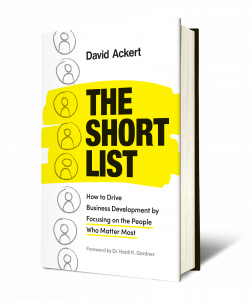To succeed in business, you must have a clear sense of what you are trying to accomplish and how you intend to focus your effort. Setting thoughtful business goals and reverse-engineering strategies that help you achieve them establishes a track you can reference and pivot toward as circumstances arise throughout the year. That’s why you and your business development team must take the time to define achievable annual business goals that reflect your firm’s optimal growth trajectory.
Frequently, busy professionals skip over the goal-setting process and default to a position of, “let’s just try to do better than last year.” They don’t recognize the two competitive advantages that goal-setting provides:
- It drives your business strategy and makes it easier to make clear business decisions throughout the year.
- It provides a clear answer to the question, “were we successful?” when reflecting at the end of the year.
But it’s easy to get fixated on culturally entrenched issues that are beyond your immediate control. That’s why we recommend a strengths-based approach to goal-setting. Performing a traditional SWOT analysis is the best way to start your business goal-setting process. Identifying your Strengths, Weaknesses, Opportunities, and Threats will put you in a much more informed position to improve your current conditions and drive business growth. Once the exercise is complete, most firms convert their Opportunities into an action list (an obvious move) but many firms make the mistake of taking their Strengths for granted, spending the rest of their strategic planning energy trying to fix Weaknesses or eliminate Threats. It’s a lot harder to tackle those areas than to simply amplify your Strengths. Here are a few examples that illustrate the point:
Amplify Your Strengths
Once you have a list of your Strengths, the question to ask yourself is, “how can we build on these characteristics?” Here are some examples:
- Branding: If your firm has a strong brand presence in certain industries or regions, a small increase in your existing marketing budget can make a significant impact in your position as a dominant leader. Your less-well-known competitor would have to spend much more to achieve the same result, so take advantage of your hard-earned position.
- Expertise: If you have a strong bench of expertise in a given area, invest in thought leadership that builds upon your existing platform. A few well-researched white papers this year will leverage the knowledge you have in-house and solidify your position as a go-to in your area. Again, if a greener competitor released a white paper, they would not attract the same level of readership. But, with a good thought leadership strategy, they might be able to take some of the market share you enjoy away from you. So, don’t take your strengths for granted. In a fast-changing landscape, if you aren’t growing, you’re losing ground.
- Size: When smaller competitors conduct their SWOT analysis, they likely list your firm among their Threats, and they console themselves by writing, “we are more nimble than bigger firms” into their Strengths column. In many cases, they may be right. The larger your firm becomes, the more likely decisions will be made by committee, and the longer it will take to pivot. So play up your size as an institutional advantage in your marketing messages to smaller markets. Smaller firms may be more agile, but they also lack the heft a larger firm can deliver.
- Pricing: Unless you have an unusually scalable, profitable model, it’s never a good idea to compete on price. You will only commoditize your offerings and set yourself up for discounts and cost-sensitive clients. In a race to the bottom, everyone loses. But if your pricing model is a strength, lead with it. Let the marketplace know that many of your clients look to your alternative fee arrangements to help them stay on budget. Ask satisfied clients to approve testimonials on your website, commenting on the value they receive from your firm’s client-centric pricing philosophy. Don’t be shy about leading with pricing if that’s one of your assets.
Apply the thinking above to the Strengths you identify in your SWOT analysis. Remember, most firms view their Strengths as hard-earned accomplishments that “speak for themselves.” It’s human nature to take our successes for granted. It is also a blind spot.
Setting Goals is Great, But Hitting Goals is Better
The Strengths you choose to amplify, along with the other goals you set in January, will require accountability, flexibility, and consistent monitoring by your business development team. Once you’ve established your targets, use customized data visualization dashboards to monitor your progress throughout the year. And avoid these three business development mistakes, so your goals don’t fall off track.







